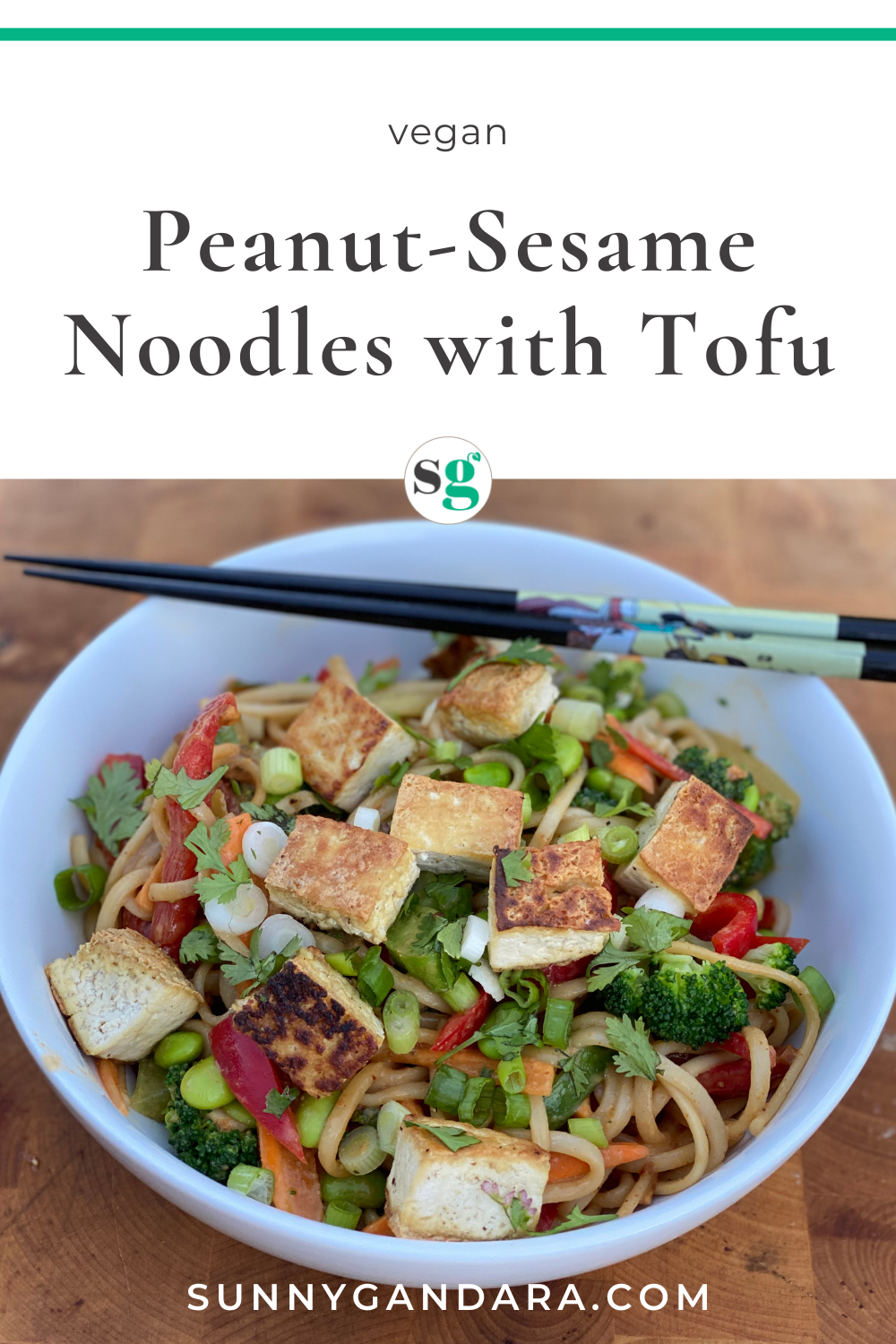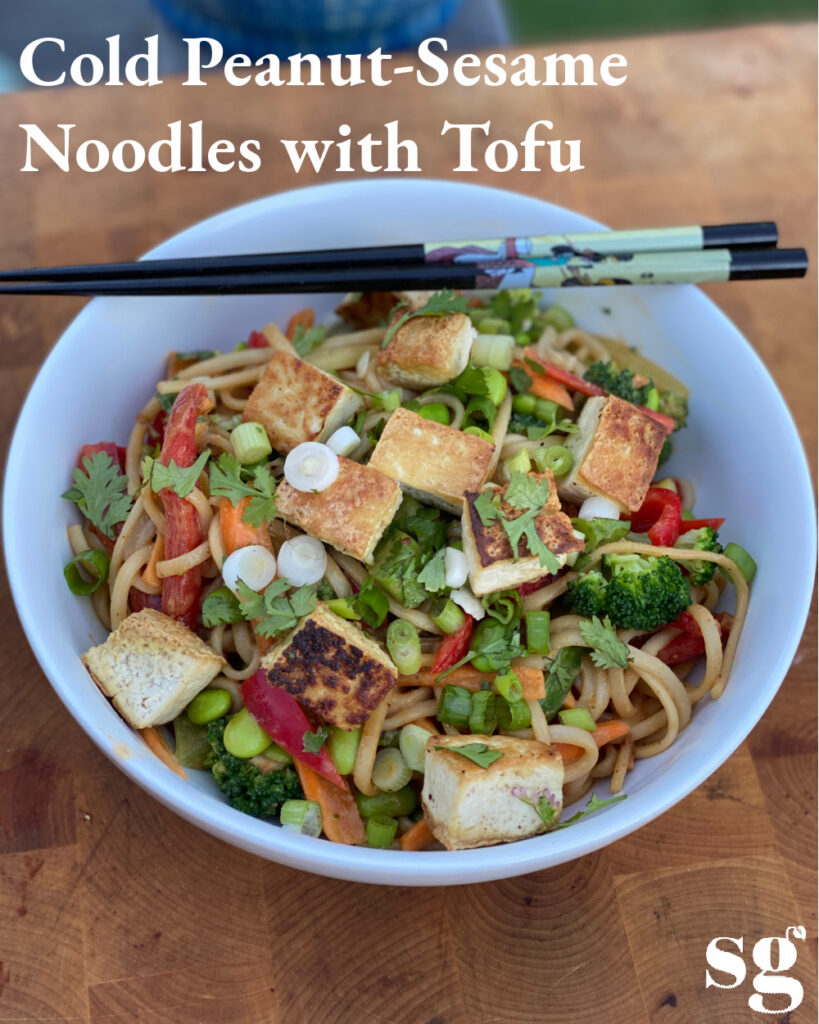I love noodles in all forms, and when I want a healthy, flavorful, quick, and easy meal I almost always resort to some type of Asian cuisine.
The other week my husband and I went shopping at a supermarket known for its amazing selection of hard-to-get Asian ingredients. It’s located about an hour south of us, so we don’t go that often but when we do we pick up tons of condiments, dry goods, spices, Asian vegetables and fruit, tofu, and…a bunch of different noodles!

This version of a sesame noodle dish with peanut sauce is more of a Chinese-American dish that was invented in the 1960s or early 1970s and first served in Chinatown, NY according to a New York Times article.
What I like about this dish is you don’t have to stress about serving it right away after you cook the noodles, as it’s presented cold and in fact, gets even more flavorful the longer it sits marinating in the sauce.
To prevent the noodles from sticking after you cook and drain them, dress them with a little sesame oil which also adds an additional depth of flavor. Rinsing them in cold water will also help get rid of excess starch and by dressing them separately with a little oil it prevents them from absorbing too much of the peanut sauce and getting gummy.
What type of noodles to use? I like the nuttiness of buckwheat/ soba noodles which I find compliments the peanut sauce, but you can also use udon or rice noodles, or even ramen noodles—they’ll still taste delicious!
The key to a flavorful sauce is to have the right combination of sweet, salty, creamy, and spicy. I like using an aged soy sauce for a deeper flavor, but any soy sauce or even tamari will do the job.
As for spice, along with some fresh ginger, I love adding Sambal Olek, which is an Indonesian chili sauce made with fresh chilis and happens to be an awesome condiment for a variety of things, I always keep it in my fridge. If you can’t find it, sriracha will do the trick too, which is another type of chili sauce often used in Thai and Vietnamese cuisine.
The sweetness comes from the addition of brown sugar, but you can also experiment with Mae Ploy, which is a delicious sweet chili sauce that will add a little heat as well.
Toasted sesame oil has a much richer flavor than regular sesame oil, so if you can find that I highly recommend it. A little goes a long way, even just a teaspoon can be enough!
Use any vegetables you have in the fridge. I recommend adding at least one or two “crunchy” ones for textures, such as carrots and scallions. Radishes and snow peas are great too.
You don’t have to add tofu if you don’t like it, but I find it makes the meal more substantial and I happen to love tofu! You can also substitute tempeh or seitan or even beans if you’d like. I incorporated some edamame along with the tofu, which is a wonderful source of protein as well.
Hope you feel inspired to try this colorful, healthy, and flavorful dish out!

As for wine pairings, you can never go wrong with champagne or a dry sparkling wine. The saltiness and richness of the peanut sauce along with the spicy elements will complement any bubbles beautifully.
Try Larmandier-Bernier’s “Latitude” Extra Brut Blanc de Blanc from all estate- organic- and biodynamically grown Chardonnay, which is one of my favorite grower champagnes and one that also doesn’t break the bank.

You might want to try an oaky Chardonnay, which pairs very well with both the peanut sauce and sesame flavor. My choice is Querciabella’s Batàr, a vegan, organic, and biodynamic stunner from Tuscany, which happens to be a blend of 50% Chardonnay with 50% Pinot Blanc.
The wine has been barrel-aged over an extended period of time in French oak and is a beautiful example of how oak can be elegantly incorporated into a wine. You’d be surprised to find a white wine of this quality in that region and truly drinks like a Grand Cru Burgundy.
In this instance, I would avoid red wine as the sauce would bring out too much metallic flavor in the wine and its salty component isn’t a great partner for high tannins.
Happy cooking and drinking!
COLD PEANUT-SESAME NOODLES WITH TOFU
Serves 4
For the sauce:
1 x 2-inch (5 cm) fresh piece ginger, peeled and minced
3-4 large garlic cloves, peeled and minced
4 tbsp peanut butter
4 tbsp soy sauce or tamari
1 tbsp Sambal Olek
2 tbsp rice vinegar
2 tbsp toasted sesame oil
2 tbsp organic brown sugar
1 x 16-oz (453 grams) package soba noodles or noodles of your choice
White sesame seeds for garnish
For the vegetables:
2 medium carrots, peeled and julienned
1 red bell pepper, sliced thin
1 head broccoli, florets divided, and stem sliced thin
1 cup edamame, shelled and thawed if using frozen
1 bunch scallions, sliced (white and light green parts only)
1-2 handfuls fresh cilantro, chopped
Lime wedges, for serving
For the tofu:
1 x 16-oz (453 g) package extra firm organic tofu, drained and pressed
Organic, neutral oil for sauteing
To make the sauce:
Whisk all the ingredients together in a small bowl and taste for any additional need to adjust saltiness (soy sauce), sweetness (brown sugar), heat (sambal olek), or creaminess (peanut butter). When you’re happy with the flavor, set aside while you prepare the remaining ingredients.
To prepare the vegetables:
All the vegetables are incorporated raw, the broccoli, which I like to blanch for a couple of minutes in salted, boiling water (be careful not to overcook as you still want them to be somewhat crunchy).
To make tofu:
Drain the block from its package, wrap in paper towels, and squeeze out any excess moisture. Alternatively, you can place a plate on top of the block with something heavy on it like a couple of cans of beans and let sit while you prepare the vegetables.
After pressing the tofu, cube it into 1-inch (2.5 cm) pieces.
Heat a large saute pan over medium-high heat and add a little neutral vegetable oil and when hot, add the tofu. Season with a little kosher salt on top and let the tofu fry for 3-4 minutes on each side until golden brown. RESIST THE URGE to move them around sooner, otherwise, they will stick to the pan and you won’t get a nice crispy exterior. Once done, set them aside.
Meanwhile cook the noodles according to the package directions, drain, rinse them in cold water, and dress them with a little extra sesame oil and set aside.
To assemble the dish:
Place all the vegetables in a large bowl, along with the cooked noodles, and dress with the peanut-sesame sauce.

Using tongs, divide a heaping serving of the vegetable-noodle mixture in each of the four bowls, top with the crispy tofu and garnish with fresh cilantro, sesame seeds, and a wedge of lime. If desired, you can also top with additional toasted peanuts. Pour your favorite glass of wine and enjoy!
WINE RECOMMENDATIONS:
2016 Querciabella Batar
NV Larmandier-Bernier “Latitude” Extra Brut Blanc de Blancs
Cold Peanut-Sesame Noodles with Tofu
This Chinese-American-inspired sesame noodle dish with peanut sauce not only tastes amazing, but you don’t have to stress about serving it right away after you cook the noodles, as it’s presented cold and in fact, gets even more flavorful the longer it sits marinating in the sauce.
- Yield: 4 1x
- Category: Main
Ingredients
For the sauce:
1 x 2-inch (5 cm) fresh piece ginger, peeled and minced
3–4 large garlic cloves, peeled and minced
4 tbsp peanut butter
4 tbsp soy sauce or tamari
1 tbsp Sambal Olek
2 tbsp rice vinegar
2 tbsp toasted sesame oil
2 tbsp organic brown sugar
1 x 16-oz (453 grams) package soba noodles or noodles of your choice
White sesame seeds for garnish
For the vegetables:
2 medium carrots, peeled and julienned
1 red bell pepper, sliced thin
1 head broccoli, florets divided and stem sliced thin
1 cup edamame, shelled and thawed if using frozen
1 bunch scallions, sliced (white and light green parts only)
1–2 handfuls fresh cilantro, chopped
Lime wedges, for serving
For the tofu:
1 x 16-oz (453 g) package extra firm organic tofu, drained and pressed
Organic, neutral oil for sauteing
Instructions
To make the sauce:
Whisk all the ingredients together in a small bowl and taste for any additional need to adjust saltiness (soy sauce), sweetness (brown sugar), heat (sambal olek), or creaminess (peanut butter). When you’re happy with the flavor, set aside while you prepare the remaining ingredients.
To prepare the vegetables:
All the vegetables are incorporated raw, the broccoli, which I like to blanch for a couple of minutes in salted, boiling water (be careful not to overcook as you still want them to be somewhat crunchy).
To make tofu:
Drain the block from its package, wrap in paper towels, and squeeze out any excess moisture. Alternatively, you can place a plate on top of the block with something heavy on it like a couple of cans of beans and let sit while you prepare the vegetables.
After pressing the tofu, cube it into 1-inch (2.5 cm) pieces.
Heat a large saute pan over medium-high heat and add a little neutral vegetable oil and when hot, add the tofu. Season with a little kosher salt on top and let the tofu fry for 3-4 minutes on each side until golden brown. RESIST THE URGE to move them around sooner, otherwise, they will stick to the pan and you won’t get a nice crispy exterior. Once done, set them aside.
Meanwhile cook the noodles according to the package directions, drain, rinse them in cold water, and dress them with a little extra sesame oil and set aside.
To assemble the dish:
Place all the vegetables in a large bowl, along with the cooked noodles and dress with the peanut-sesame sauce.
Using tongs, divide a heaping serving of the vegetable-noodle mixture in each of the four bowls, top with the crispy tofu and garnish with fresh cilantro, sesame seeds, and a wedge of lime. If desired, you can also top with additional toasted peanuts. Pour your favorite glass of wine and enjoy!
Notes
To prevent the noodles from sticking after you cook and drain them, dress them with a little sesame oil which also adds an additional depth of flavor. Rinsing them in cold water will also help get rid of excess starch and by dressing them separately with a little oil it prevents them from absorbing too much of the peanut sauce and getting gummy.
What type of noodles to use? I like the nuttiness of buckwheat/ soba noodles which I find compliments the peanut sauce, but you can also use udon or rice noodles, or even ramen noodles—they’ll still taste delicious!
The key to a flavorful sauce is to have the right combination of sweet, salty, creamy, and spicy. I like using an aged soy sauce for a deeper flavor, but any soy sauce or even tamari will do the job.
As for spice, along with some fresh ginger, I love adding Sambal Olek, which is an Indonesian chili sauce made with fresh chilis and happens to be an awesome condiment for a variety of things, I always keep it in my fridge. If you can’t find it, sriracha will do the trick too, which is another type of chili sauce often used in Thai and Vietnamese cuisine.
The sweetness comes from the addition of brown sugar, but you can also experiment with Mae Ploy, which is a delicious sweet chili sauce that will add a little heat as well.
Toasted sesame oil has a much richer flavor than regular sesame oil, so if you can find that I highly recommend it. A little goes a long way, even just a teaspoon can be enough!
Use any vegetables you have in the fridge. I recommend adding at least one or two “crunchy” ones for textures, such as carrots and scallions. Radishes and snow peas are great too.
You don’t have to add tofu if you don’t like it, but I find it makes the meal more substantial and I happen to love tofu! You can also substitute tempeh or seitan or even beans if you’d like. I incorporated some edamame along with the tofu, which is a wonderful source of protein as well.




0 Comments